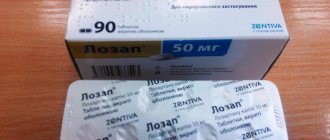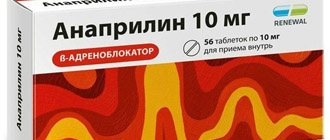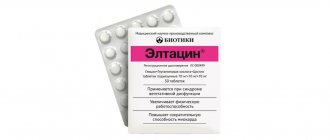Composition and release form
The drug Lozap is available in the form of small tablets for parenteral administration. They are white, slightly elongated and convex on both sides. They have a soluble thin film shell. Packaged in blisters of 10 pieces. One cardboard package contains 3, 6, 9 blisters and includes instructions for use.
The active substance is potassium losartran.
Auxiliary components: cellulose, povidone, talc, magnesium stearate, macrogol, dyes, mannitol, croscarmellose sodium.
pharmachologic effect
The drug belongs to the group of antihypertensive drugs. It is a specific angiotensin receptor agonist. After taking the medicine, there is a decrease in vascular resistance, a decrease in aldosterone and adrenaline levels in the bloodstream. In addition, the pressure in the pulmonary circulation is normalized, a pronounced diuretic effect occurs and the afterload on the body is reduced.
The drug prevents the development of hypertrophy of the muscular lining of the heart and improves people's susceptibility to physical activity.
While taking the drug, the angiotensin-containing enzyme is not blocked. Therefore, the level of bradykinin does not increase and the effect on the kinin system is prevented.
The pharmacological effect of the drug is the same for all patients, regardless of age and gender.
After one dose of medication, the hypotensive effect is observed after 6 hours and gradually decreases throughout the day. When a course is prescribed, pronounced results of therapy appear in patients after 3-4 weeks.
People suffering from liver cirrhosis should be careful when using antihypertensive drugs. The active ingredient occurs in their blood. Therefore, they need dose adjustment.
After oral administration, the tablets are quickly absorbed. The maximum content of the drug in the body is recorded after an hour. The drug is administered through the kidneys and intestines.
Lozap® plus
Losartan
Cases of decreased concentrations of the active metabolite have been described with the combined use of rifampicin and fluconazole. Clinical evidence for such interactions has not been evaluated.
As with other drugs that block angiotensin II or its effects, concomitant use of potassium-sparing diuretics (eg, spironolactone, triamterene, amiloride), potassium supplements, or potassium-containing salt substitutes may result in increased serum potassium levels. The combined use of these drugs is not recommended. As with other drugs that affect sodium excretion, the drug may slow down the excretion of lithium. Therefore, when prescribing lithium salts and ARA II simultaneously, it is necessary to carefully monitor the level of lithium salts in the blood serum.
With the simultaneous use of ARA II and NSAIDs, for example, selective COX-2 inhibitors, acetylsalicylic acid in doses used for anti-inflammatory effect, and non-selective NSAIDs, a weakening of the antihypertensive effect of Lozap® Plus may be observed. Concomitant use of ARB II or diuretics and NSAIDs may cause an increased risk of deterioration of renal function, including acute renal failure and increased serum potassium levels, especially in patients with underlying renal impairment. Combination treatment should be prescribed with caution, especially in elderly patients. Patients should be adequately hydrated and renal function monitored after initiation of combination treatment and periodically during treatment.
In some patients with impaired renal function receiving treatment with NSAIDs, incl. selective COX-2 inhibitors, simultaneous use of angiotensin II receptor antagonists may aggravate renal dysfunction. These effects are usually reversible.
Other drugs that cause hypotension, such as tricyclic antidepressants, antipsychotic drugs, baclofen, amifostine: simultaneous use of Lozap® Plus with these drugs that lower blood pressure may increase the risk of developing arterial hypotension.
Hydrochlorothiazide
When taken simultaneously with thiazide diuretics, interactions with the following substances may occur:
Alcohol, barbiturates, opioid analgesics or antidepressants:
The risk of orthostatic hypotension may increase.
Antidiabetic drugs (insulin and oral drugs):
Treatment with thiazide diuretics may affect glucose tolerance. Dosage adjustment of antidiabetic drugs may be required. Metformin should be used with caution due to the risk of lactic acidosis caused by possible functional renal failure associated with the use of hydrochlorothiazide.
Other antihypertensive drugs:
additive effect.
Cholestyramine and colestipol:
in the presence of ion exchange resins, the absorption of hydrochlorothiazide is impaired. Taking a single dose of cholestyramine or colestipol leads to the binding of hydrochlorothiazide and a decrease in its absorption from the gastrointestinal tract by 85% and 43%, respectively.
Corticosteroids, adrenocorticotropic hormone (ACTH):
aggravation of electrolyte deficiency, especially hypokalemia, is possible.
Pressor amines (for example, adrenaline):
it is possible to reduce the effect of pressor amines, however, this does not exclude their use.
Non-depolarizing muscle relaxants (for example, tubocurarine chloride):
the effect of muscle relaxants may be enhanced.
Lithium preparations:
diuretics reduce the renal clearance of lithium and significantly increase the risk of lithium toxicity. It is recommended to avoid the simultaneous use of hydrochlorothiazide with lithium preparations.
Medicines for the treatment of gout (probenecid, sulfinpyrazone and allopurinol):
Dosage adjustments of antigout medications may be necessary because hydrochlorothiazide may increase serum uric acid levels. Concomitant use with thiazides may increase the incidence of hypersensitivity reactions to allopurinol.
Anticholinergic drugs (eg, atropine, biperidine):
it is possible to increase the bioavailability of thiazide diuretics by reducing gastrointestinal motility and the rate of gastric emptying.
Cytotoxic drugs (eg, cyclophosphamide, methotrexate):
Thiazide diuretics can inhibit the renal excretion of cytotoxic drugs and enhance their myelosuppressive effect.
Salicylates:
when using high doses of salicylates, hydrochlorothiazide may enhance their toxic effects on the central nervous system.
Methyldopa:
Isolated cases of the development of hemolytic anemia have been described in patients simultaneously receiving hydrochlorothiazide and methyldopa.
Cyclosporine:
concomitant treatment with cyclosporine may increase the risk of hyperuricemia and complications of gout.
Cardiac glycosides:
Hypokalemia or hypomagnesemia caused by thiazide diuretics may contribute to the development of digitalis-induced arrhythmias.
Drugs whose effect is affected by changes in serum potassium levels:
When Lozap® Plus is co-administered with drugs whose effect is affected by changes in potassium levels (for example, digitalis glycosides and antiarrhythmic drugs), it is recommended to regularly monitor serum potassium levels and ECG monitoring. These measures are also recommended when using Lozap® Plus simultaneously with the following drugs that can cause torsades de pointes (including antiarrhythmics), since hypokalemia is a factor predisposing to the development of torsades de pointes: class IA antiarrhythmics (for example , quinidine, hydroquinidine, disopyramide), class III antiarrhythmics (eg, amiodarone, sotalol, dofetilide, ibutilide), some antipsychotics (eg, thioridazine, chlorpromazine, levomepromazine, trifluoperazine, cyamemazine, sulpride, sultopride, amisulpride, tiapride, pimozide, haloperidol, droperidol), others (for example, bepridil, cisapride, difemanil, erythromycin IV, halofantrine, mizolastine, pentamidine, terfenadine, vincamycin IV).
Calcium salts:
Thiazide diuretics may increase serum calcium levels by decreasing calcium excretion. If the patient is taking calcium supplements, it is necessary to monitor the level of calcium in the blood serum and, accordingly, adjust the dosage of calcium supplements.
Impact on laboratory results:
Due to their effect on calcium metabolism, thiazides may distort the results of tests to assess the function of the parathyroid glands.
Carbamazepine:
there is a risk of developing symptomatic hyponatremia. Clinical observation and laboratory monitoring of blood sodium levels are necessary in patients taking carbamazepine.
Iodinated contrast agents:
in case of dehydration caused by the use of diuretics, the risk of developing acute renal failure increases, especially when taking high doses of iodine preparations. Patients should be rehydrated before administration.
Amphotericin B (for parenteral administration), corticosteroids, ACTH, stimulant laxatives or glycyrrhizin (found in licorice):
hydrochlorothiazide may cause electrolyte deficiency, especially hypokalemia.
Lozap indication
The use of Lozap is relevant for the following conditions:
- High blood pressure.
- Chronic course of heart failure.
- Prevention of the development of severe vascular and cardiac diseases among patients with hypertension and left ventricular enlargement.
- Nephropathy and high blood pressure in people with diabetes.
- Contraindications
- Absolute contraindications for use are:
- Increase in potassium levels in the blood.
- Low pressure.
- Individual intolerance to the medicinal components included in the composition.
- The time of bearing a child.
- Breastfeeding.
- Symptoms of dehydration.
- Children under 18 years of age.
Lozap
Hypersensitivity
Patients with a history of angioedema (swelling of the face, lips, pharynx and/or tongue) should be closely monitored.
Arterial hypotension and water-electrolyte imbalance
Symptomatic hypotension, especially after the first dose or after dose increases, may occur in patients with hypovolemia and/or hyponatremia as a result of high-dose diuretics, a salt-restricted diet, diarrhea or vomiting. It is necessary to either correct these conditions before prescribing the drug LOZAP®, or use or prescribe lower doses of the drug.
Fluid and electrolyte disturbances
Water and electrolyte disturbances are typical for patients with impaired renal function in combination with or without diabetes mellitus and require correction. In a clinical study conducted in patients with type 2 diabetes mellitus with nephropathy, the incidence of hyperkalemia in the losartan group was higher than in the placebo group. This indicates the need for regular monitoring of potassium levels in the blood plasma and creatinine clearance (CC) indicators - patients with heart failure and creatinine clearance from 30 to 50 ml/min require especially strict monitoring. Prescribing potassium-sparing diuretics, potassium preparations and potassium-containing salt substitutes simultaneously with LOZAP® is not recommended.
Liver dysfunction
Taking into account pharmacokinetic data indicating a significant increase in plasma concentrations of losargan in patients with cirrhosis, patients with a history of impaired liver function (more than 9 points on the Child-Pugh scale) are recommended to prescribe the drug in lower doses. There is no experience with the use of the drug in patients with severe liver failure. Taking this into account, LOZAP® is contraindicated in patients with severe liver failure.
Dual blockade of the renin-angiotensin-aldosterone system
There is evidence that the simultaneous use of ACE inhibitors. APAII or aliskiren increases the risk of arterial hypotension, hyperkalemia and renal dysfunction (including acute renal failure).
The use of LOZAP® together with alnekiren is contraindicated in patients with diabetes mellitus or impaired renal function (GFR less than 60 ml/min/1.73 m2 body surface area) and is not recommended for other patients (see section “Contraindications”).
The use of LOZAP® in combination with an ACE inhibitor is contraindicated in patients with diabetic nephropathy and is not recommended for other patients (see section “Contraindications”).
Coronary heart disease (CHD) and cerebrovascular diseases
As with any antihypertensive drugs, too sharp a decrease in blood pressure in patients with coronary artery disease and cerebrovascular diseases can lead to myocardial infarction or ischemic stroke.
Heart failure
In patients with heart failure with or without renal impairment, as with other drugs acting on the RAAS, there is a risk of severe hypotension and acute renal failure.
There is virtually no experience with the use of losartan in the treatment of patients with heart failure and concomitant severe renal failure, in patients with severe chronic heart failure (NYHA functional class IV), as well as in patients with heart failure and life-threatening arrhythmias. Taking this into account, caution should be exercised when prescribing the drug LOZAP® to these categories of patients.
Combined use with ACE inhibitors in chronic heart failure (CHF)
When using the drug LOZAP® in combination with ACE inhibitors, the risk of side effects may increase, especially renal dysfunction and hyperkalemia (see section “Side Effects”). In these cases, careful observation and monitoring of laboratory parameters is necessary.
Hemodialysis
During hemodialysis, the sensitivity of blood pressure to the action of AT1 receptor antagonists increases as a result of a decrease in blood volume and activation of the RAAS. It is necessary to adjust the dose of LOZAP® under close monitoring of blood pressure in patients on hemodialysis. Kidney transplantation There are no data on the use of LOZAP® in patients who have recently undergone kidney transplantation.
General anesthesia
In patients receiving angiotensin II antagonists, arterial hypotension may develop during general anesthesia and surgical procedures as a result of blockade of the renin-angiotensin-aldosterone system. Very rarely, cases of severe arterial hypotension may occur, requiring replenishment of blood volume and/or vasopressor drugs.
Aortic and mitral titanium stenosis, hypertrophic obstructive cardiomyopathy
When using the drug LOZAP®, as well as other vasodilators, caution should be exercised in patients with hypertrophic obstructive cardiomyopathy or hemodynamically significant stenosis of the aortic or mitral valve.
Primary hyperaldosteronism
Patients with primary hyperaldosteronism are usually resistant to treatment with antihypertensive drugs that affect the RAAS. In this regard, the drug LOZAP® is not recommended for such patients.
Patients over 75 years of age
As a rule, patients over 75 years of age are recommended to start treatment with LOZAP® with a dose of 25 mg per day.
Other special instructions and precautions
As clinical experience with the use of ACE inhibitors, losartan and other AT1 receptor antagonists shows, these drugs are less effective in reducing blood pressure in patients of the Black race than in representatives of other races, possibly due to low renin activity in patients of this race.
Side effects
As a rule, during the course of therapy, patients experience virtually no side effects. If they appear, they go away on their own and quickly, so there is no need to discontinue the drug. The following side effects are possible when taking Lozap:
- Dizziness, increased fatigue, headache, problems falling asleep. Migraines, anxiety, tremor, and depression are less common.
- Infection of the respiratory system. Signs of rhinitis, bronchitis and respiratory distress may appear.
- Dyspeptic symptoms, rarely gastritis, dry mouth, flatulence.
- Disturbance of the musculoskeletal system. Possible pain in the back and muscles, cramps.
- Signs of cardiac dysfunction are expressed in tachycardia, bradycardia, arrhythmia.
- Rarely, kidney problems, sexual dysfunction and infections of the urinary system appear.
- Allergic reactions, dry dermis, excessive sweating.
Instructions for use of Lozap
The medicine is intended for oral administration, regardless of the time of meal. It is recommended to take the tablets once a day.
For severe hypertension, patients are prescribed 50 mg. According to clinical indications, the dosage can be doubled.
According to the attached instructions, in case of cardiac insufficiency, patients are prescribed 12.5 mg once a day. Every week the dose of the drug is increased by 2 times until it reaches 50 mg per day.
In cases where patients are simultaneously taking diuretic drugs, the therapeutic dose of Lozap should be reduced to 25 mg.
Elderly people and those with kidney problems do not need to change the therapeutic dosage.
Lozap plus tablets 50 mg+12.5 mg 90 pcs.
The combined drug has a hypotensive effect. Contains losartan potassium - an angiotensin II receptor blocker (antagonist) (AT1 subtype) (ARB) and hydrochlorothiazide - a thiazide diuretic. Losartan/hydrochlorothiazide. Losartan and hydrochlorothiazide demonstrate a synergistic hypotensive effect, reducing blood pressure (BP) to a greater extent than either component alone. It is assumed that this effect is the result of the additive action of both components. In addition, as a result of the diuretic effect, hydrochlorothiazide increases plasma renin activity, aldosterone secretion, reduces the concentration of potassium in the blood plasma and increases the content of angiotensin-II. The use of losartan blocks all physiologically significant actions of angiotensin-II and reduces potassium losses associated with diuretic use through inhibition of aldosterone. Losartan has a mild and short-term uricosuric effect. Hydrochlorothiazide leads to a moderate increase in plasma uric acid; the combination of losartan and hydrochlorothiazide helps to attenuate diuretic-induced hyperuricemia. The hypotensive effect of losartan/hydrochlorothiazide persists for 24 hours. Despite a significant decrease in blood pressure, taking losartan/hydrochlorothiazide does not have a significant clinical effect on heart rate (HR). In clinical studies, it was shown that after 12 weeks of therapy with losartan 50 mg/hydrochlorothiazide 12.5 mg, minimum diastolic blood pressure (measured in the sitting position) decreased by an average of 13.2 mmHg. Art. Losartan/hydrochlorothiazide effectively reduces blood pressure in men and women, patients of black and other races, in young (< 65 years) and elderly (≥ 65 years) patients, and in all degrees of arterial hypertension. Losartan. Losartan is a synthetic angiotensin II receptor blocker (AT1 type). Angiotensin II, a powerful vasoconstrictor, is the main active hormone of the renin-angiotensin-aldosterone system (RAAS) and a major factor in the pathophysiology of arterial hypertension. Angiotensin II binds to AT1 receptors found in many tissues (vascular smooth muscle, adrenal glands, kidneys and heart) and causes a number of biologically important effects, including vasoconstriction and aldosterone release. Angiotensin II also stimulates the proliferation of smooth muscle cells. Losartan selectively blocks AT1 receptors. Losartan and its pharmacologically active carboxyl metabolite E-3174 block all physiologically significant effects of angiotensin-II in vitro and in vivo, regardless of the source and route of synthesis of the latter. Losartan does not have an agonistic effect and does not block other hormone receptors or ion channels that play an important role in regulating the function of the cardiovascular system. In addition, losartan does not inhibit angiotensin-converting enzyme (ACE) (kininase II), an enzyme that breaks down bradykinin. Therefore, there is no potentiation of undesirable effects mediated by bradykinin. When using losartan, elimination of the negative feedback reaction of angiotensin-II on renin secretion leads to an increase in the activity of the latter in the blood plasma. An increase in renin activity leads to an increase in the concentration of angiotensin-II in the blood plasma. Despite this increase, hypotensive activity and a decrease in plasma aldosterone concentrations persist, indicating effective blockade of angiotensin-II receptors. After stopping the use of losartan, plasma renin activity and angiotensin-II levels return to baseline values within 3 days. Both losartan and its main active metabolite have a greater affinity for AT1 receptors than for AT2 receptors. This metabolite is 10-40 times more active than losartan. The incidence of cough is comparable in patients taking losartan or hydrochlorothiazide and significantly lower than when using an ACE inhibitor. In patients with arterial hypertension, proteinuria without diabetes mellitus and taking losartan, there was a significant decrease in proteinuria, fractional release of proteins and immunoglobulin G. Losartan stabilizes the glomerular filtration rate and reduces the filtration fraction. In general, losartan causes a decrease in serum uric acid levels that persists during long-term therapy. Losartan does not affect autonomic reflexes and does not have a long-term effect on the level of norepinephrine in the blood plasma. In patients with left ventricular failure, 25 mg and 50 mg of losartan have positive hemodynamic and neurohumoral effects, characterized by an increase in cardiac index and a decrease in pulmonary capillary wedge pressure, systemic vascular resistance, mean systemic arterial pressure and heart rate, as well as plasma aldosterone and norepinephrine concentrations blood, respectively. The development of hypotension in these patients with heart failure was dose-dependent. Hydrochlorothiazide is a thiazide diuretic. The mechanism of the antihypertensive effect of this group of drugs is not fully known. Thiazide diuretics affect the renal tubular reabsorption mechanisms of electrolytes, directly increasing the excretion of sodium and chloride in approximately equivalent amounts. The diuretic effect of hydrochlorothiazide reduces plasma volume, increases plasma renin activity and increases aldosterone secretion with a subsequent increase in urinary potassium concentrations and bicarbonate loss and a decrease in plasma potassium concentrations. The coupling of renin to aldosterone is mediated by angiotensin II, and therefore concomitant use of an ARB generally reverses the potassium loss caused by thiazide diuretics. When taken orally, the diuretic effect of hydrochlorothiazide begins after 2 hours, reaches a maximum, on average, after 4 hours and lasts from 6 to 12 hours, the hypotensive effect persists for 24 hours.
Interactions with drugs
Combining the drug with Fluconazole and Rifampicin leads to a decrease in the active substance.
Lozap increases the pharmacological activity of other antihypertensive drugs.
It is not recommended to take the medicine in parallel with non-steroidal anti-inflammatory drugs.
When interacting with potassium and potassium-sparing diuretics, it is important to monitor the level of the element in the blood to prevent the occurrence of hyperkalemia.
Patients with obvious symptoms of dehydration while taking diuretics may experience a rapid decrease in blood pressure when taking an antihypertensive drug.









